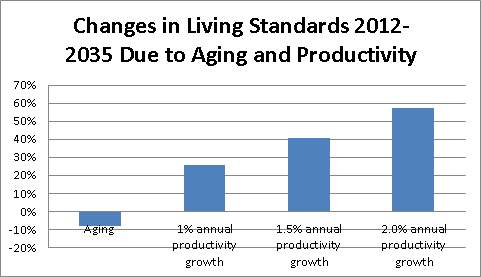Article
Fact-based, data-driven research and analysis to advance democratic debate on vital issues shaping people’s lives.
Center for Economic and Policy Research
1611 Connecticut Ave. NW
Suite 400
Washington, DC 20009
Tel: 202-293-5380
Fax: 202-588-1356
https://cepr.net
One of themes that recurs endlessly in news coverage is that the United States and other countries face a disastrous threat to their living standards as a result of a falling ratio of workers to retirees. This is one that can be easily dismissed with some simple arithmetic.
A falling ratio of workers to retirees means that a larger chunk of what each worker produces must be put aside to a support the retired population. (Btw, this is true regardless of whether or not we have a Social Security or Medicare system. The only issue is whether retirees are able to maintain something resembling normal living standards.) However, that does not imply that the working population must see a drop in their living standards.
Fans of arithmetic might note that the ratio of workers to retirees fell from 5 to 1 in the early sixties to 3 to 1 in the early 90s. This sharp drop in the ratio of workers to retirees did not prevent both workers and retirees from enjoying substantial improvements in living standards over this period. The reason is that productivity growth, what each workers produces in an hour of work, swamped the impact of a falling ratio of workers to retirees.
That will also be the case as the ratio of workers to retirees falls from the current 3 to 1 to a bit under 2 to 1 over the next 23 years under any plausible assumption about productivity growth. The chart below compares the impact of the decline in the ratio of workers to retirees in reducing the living standards with the impact of productivity growth in raising living standards, assuming that the average retiree consumes 85 percent as much as the average worker.

Source: Author’s calculations.
The 1.0 percent growth bar shows the impact of productivity growth assuming that going forward it is worse than at any point in the post-war era. (Even in the period of the productivity slowdown, from 1973-1995 growth was somewhat more rapid than this.) In this case the 25.7 percent increase in living standards allowed by higher productivity growth is more than three times the 7.8 percent decline resulting from a fall in the ratio of workers to retirees.
If annual productivity growth is closer to 1.5 percent, roughly the rate that we have been seeing for the last 17 years, then the gains in living standards will be 40.8 percent, more than five times the size of the negative impact from demographics. And if productivity growth were to rebound to 2.0 percent annually (still somewhat less than the 1947-73 golden era rate) the cumulative increase in living standards would be 57.7 percent, a bit less than eight times as large as the impact of demographics in lowering living standards. (Note that these measures of productivity are adjusted to calculate the portion of growth that actually translates into potential gains for workers. For this reason, they are very conservative.)
In short, under any plausible scenario the potential gains to living standards from increased productivity swamp any potential negative impact from a declining ratio of workers to retirees. And these calculations do not even take account of unmeasured benefits of slower population growth, like less pollution and reduced strains on the infrastructure. It is also important to remember that these numbers show the absolute largest impact of demographics. If we were look out another 10 years to 2045, the demographics would not change, while productivity would continue to raise living standards.
In short, the idea that demographics will impoverish our children and grandchildren is absurd on its face. Readers may rightly note than most workers have not see the gains of productivity growth over the last three decades, but this just highlights the importance of intra-generational distribution. The impact of battles over distribution of income within generations will dwarf the impact of battles over distribution between generation.
When people being portrayed as policy experts tell you that the United States or other countries face a demographic disaster because of declining ratios of workers to retirees they are mostly trying to tell you that they are not very good arithmetic.